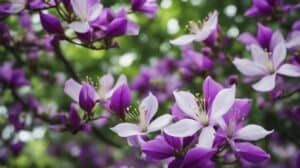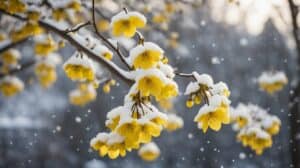Russelia equisetiformis, commonly known as firecracker plant, is a popular ornamental plant that is native to Mexico and Central America.
It is a fast-growing plant that produces bright red, tubular flowers that resemble firecrackers, hence the name.
Firecracker plant is a great addition to any garden or landscape, as it is low-maintenance and attracts hummingbirds and butterflies.

For those who are new to gardening or are looking to add some color to their landscape, growing firecracker plant is a great option.
This plant is easy to grow and care for, making it perfect for beginners.
With the right growing conditions, firecracker plant can thrive in a variety of settings, from containers to garden beds.
In this article, we will explore the basics of growing Russelia equisetiformis and provide tips for ensuring its success.
Discovering Russelia Equisetiformis
Russelia equisetiformis, also known as the Firecracker Plant, is a stunning, low-maintenance plant that can add a vibrant pop of color to any garden.
This section will explore the origin and botanical profile of Russelia equisetiformis, as well as some of its common names.
Origin and Botanical Profile
Russelia equisetiformis is native to Mexico and Central America, where it grows in hot, dry conditions.
It is a member of the Plantaginaceae family and is related to snapdragons and foxgloves.
The plant has thin, grass-like leaves that are a bright green color, and it produces long, tubular flowers that are typically bright red or orange.
These flowers bloom in the summer and fall, attracting hummingbirds and butterflies to the garden.
Common Names
Russelia equisetiformis is commonly known as the Firecracker Plant due to its explosive bursts of color.
It is also sometimes called Coral Plant, Fountain Plant, or Coral Fountain.
Overall, Russelia equisetiformis is a beautiful and easy-to-grow plant that can bring color and life to any garden.
Whether you’re a seasoned gardener or a beginner, this plant is a great choice for adding some excitement to your outdoor space.
Cultivation Essentials

Climate and Sunlight Requirements
The Firecracker plant, Russelia equisetiformis, thrives in warm and sunny climates.
It is a hardy plant that can tolerate a range of temperatures, but it prefers temperatures between 60-80°F.
It is essential to provide the plant with plenty of sunlight, at least 6 hours of direct sunlight per day.
If grown indoors, it is best to place it near a south-facing window or under grow lights.
Soil and Watering Needs
The Firecracker plant prefers well-draining soil that is rich in organic matter. A mix of peat moss, perlite, and sand is ideal.
It is essential to keep the soil moist but not waterlogged. Overwatering can lead to root rot and other diseases.
Water the plant when the top inch of soil feels dry to the touch. In hot weather, the plant may require more frequent watering.
Fertilization and Pruning Tips
The Firecracker plant is a moderate feeder and benefits from regular fertilization during the growing season.
Use a balanced fertilizer every two weeks or a slow-release fertilizer every two months.
Pruning is not necessary but can help to keep the plant tidy and promote bushier growth.
Prune the plant in the spring or fall by cutting back any dead or damaged stems. The plant can also be cut back to control its size.
Landscape and Design Uses

Russelia equisetiformis, commonly known as the Firecracker plant, is a versatile plant that can be used in various landscape and design settings.
Here are some ideas on how to incorporate this plant into your garden:
Garden Aesthetics
The Firecracker plant is an excellent choice if you want to add a pop of color to your garden.
Its bright red tubular flowers are eye-catching and can attract hummingbirds and butterflies.
You can plant it in groups or use it as a focal point in your garden bed.
The plant’s slender stems and delicate foliage can also add texture to your garden.
Companion Plants
The Firecracker plant can be used as a companion plant to other plants in your garden.
It pairs well with plants that have contrasting foliage colors or textures.
For example, you can plant it alongside plants with dark green leaves, such as boxwood or holly, to create a striking contrast.
You can also pair it with plants that have fine, feathery foliage, such as ferns or ornamental grasses, to create a soft and airy look.
In summary, the Firecracker plant is a versatile plant that can add color and texture to your garden.
Use it as a focal point or a companion plant, and pair it with other plants to create a visually appealing garden.
Propagation and Maintenance

Seed and Cuttings Propagation
Russelia equisetiformis is a fast-growing plant that can be propagated from both seeds and cuttings.
To propagate from seeds, collect them from the plant after they have ripened and dried.
Sow the seeds in well-draining soil and keep them moist until they germinate. It takes about 2-3 weeks for the seeds to germinate.
Cuttings are taken from the plant in spring or summer. Choose a healthy stem and cut it to a length of about 4-6 inches.
Remove the leaves from the lower half of the stem and dip the cut end in rooting hormone.
Plant the cutting in well-draining soil and keep it moist until it roots. It takes about 2-3 weeks for the cutting to root.
Pest Management
Firecracker plants are generally pest-free, but they can be attacked by spider mites and whiteflies.
To prevent these pests, keep the plant in a well-ventilated area and avoid overwatering.
If you notice any pests on the plant, spray it with a mixture of water and neem oil.
Disease Prevention
Firecracker plants are susceptible to root rot if they are overwatered or planted in poorly draining soil.
To prevent root rot, ensure the soil is well-draining and avoid overwatering the plant.
If you notice any signs of root rot, such as yellowing leaves or wilting, remove the affected parts of the plant and repot it in fresh soil.
Overall, Russelia equisetiformis is an easy-to-care-for plant that is perfect for beginners.
With proper propagation and maintenance techniques, you can enjoy this beautiful plant for many years to come.
Frequently Asked Questions

How do I properly care for a Russelia equisetiformis in a container?
To care for a Russelia equisetiformis in a container, make sure to use well-draining soil and a container with drainage holes.
Water the plant regularly, but do not let the soil become waterlogged.
Fertilize the plant every two to three weeks during the growing season with a balanced fertilizer.
Prune the plant to maintain its shape and remove any dead or damaged branches.
Can firecracker plants thrive in shaded areas or do they require full sun?
Firecracker plants require full sun to thrive. They can tolerate some shade, but they will not bloom as profusely in shaded areas.
What are the common issues that can affect firecracker plants and how can I address them?
Common issues that can affect firecracker plants include spider mites, scale insects, and root rot.
To address spider mites and scale insects, use insecticidal soap or neem oil.
To prevent root rot, make sure the soil is well-draining and do not overwater the plant.
What steps should I take to propagate a firecracker plant effectively?
To propagate a firecracker plant, take stem cuttings in the spring or summer. Dip the cuttings in rooting hormone and plant them in well-draining soil.
Keep the soil moist and the cutting in a shaded area until it has rooted, then gradually introduce it to more sunlight.
Are firecracker plants safe for pets, or are they toxic to animals like dogs?
Firecracker plants are non-toxic to pets and are safe for dogs and cats.
Do firecracker plants attract wildlife, such as hummingbirds, to the garden?
Firecracker plants are known to attract hummingbirds to the garden with their bright red flowers.














